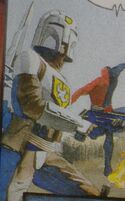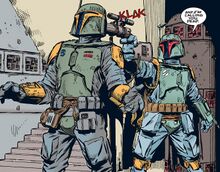Mandalorian armor/Legends
- "There are two reasons why we have to wear armor. One is so that we don't get killed too easily. The other is so that we all look Mandalorian, however different we may be from our brothers and sisters."
- ―A Mandalorian mother to her daughter
The most recognizable symbol of the Mandalorian culture, Mandalorian armor was a catch-all term for the sets of distinctive full-body armor worn by Mandalorian warriors and soldiers throughout galactic history. Known as beskar'gam in the Mandalorian language of Mando'a—a name which meant "iron skin" in Basic—Mandalorian armor was central to the Mandalorian way of life. The wearing of armor was one of the Resol'nare, the six tenets that defined the Mandalorian culture. In an expansive community comprising beings from numerous origins, the easily identifiable armor not only provided protection for the wearer, but a common visual identity for any and all Mandalorians, regardless of species or gender.
The specific design of Mandalorian armor evolved over time, gaining more sophisticated features over the years, including the incorporation of advanced helmet heads-up displays, and armor-mounted weapon systems such as flamethrowers and wrist rocket launchers. However, one of the armor's most lasting features was the T-shaped visor that adorned the helmet's face across its various incarnations. Numerous materials were employed in the creation of Mandalorian armor through the millennia, from alum and durasteel, to stygian-triprismatic polymer and the nearly indestructible beskar iron. Mandalorian armor forged from beskar was highly prized for its incredible resilience, and while sets of armor were often passed down from one generation to the next, beskar armor was considered the most valuable. The appearance of a Mandalorian's armor was largely up to the individual, as the highly independent Mandalorian people customized their armor with different colored paint schemes, clan and unit sigils, personalized glyphs, or other marking patterns in accordance to their own tastes.
History
The design of Mandalorian armor changed a great deal in the seven millennia after the Taung first settled the planet Mandalore.
The first, widely recognizable version was the Crusader Armor, which was the signature armor worn by the Mandalorian Crusaders led by Mandalore the Indomitable during the Great Sith War. It had a jagged, organic form that varied from soldier to soldier. The design of Crusader Armor was centered on defending its wearer during melee combat, which the Mandalorians considered the most honorable form of battle.[2]
During Mandalore the Ultimate's reign as Mandalore, the Neo-Crusader armor was designed by Cassus Fett for use in the Mandalorian Wars to foster a sense of unity among the many disparate species being recruited into the Neo-Crusader movement. By the invasion of Taris, the Neo-Crusaders' beliefs had spread far and wide among the Mandalorian clans and the armor all but replaced the earlier, more individualized suits. Neo-Crusader armor came in four colors, each corresponding to a rank—silver for veterans on the front line, gold for Field Marshals, crimson for Rally Masters and blue for all others. Later in the war, new armors were developed for use by special units such as the Neo-Crusader Shock Troopers.[10]
During the time of the Cold War, a proxy conflict between the Sith Empire and Galactic Republic, both Mandalorian armors and weaponry were seen in the hands of Outer Rim pirates. Eventually, someone was assigned to discover the source of the materials.[11]
Millennia later, the Mandalorian Supercommando armor was developed to replace the older designs which were now referred to as Mandalorian Shock Trooper Armor. It was no longer full-body armor, but partial armor that left limbs almost completely undefended, and focused its strength on the vital areas such as the torso, head, and groin. The new armor was a collection of blast-resistant plates, made from Mandalorian iron or duraplast, which were attached to a waterproof, armorweave flight suit. A liner shirt with a micro energy field projector and two layers of ceramic plates greatly improved protection around the chest, back, and stomach. This careful layering of segmented armor plates ensured mobility, which could be further increased by wearing a jetpack. The Mandalorians began to see the value of extra weapons mounted on the suit, and so simple dart shooters, grappling wires, wrist-mounted rocket launchers and flamethrowers were added to the overall assault capabilities of a Mandalorian Supercommando.[2][5]
The classic Mandalorian design could also be seen in the armor of clone troopers, and evolved from the basic clone trooper and Katarn-class commando armor specs to those of the armor of Imperial stormtroopers and the Emperor's Royal Guard.[12]
Design
Throughout Mandalorian history, three major features remained constant in Mandalorian armor design:
- The wearer was protected from the majority of blaster fire. Armor made of Mandalorian iron, which could also deflect blaster bolts, was lightsaber-resistant.
- The helmets almost always possessed a T-shaped visor and a sophisticated heads-up display (HUD).
- Mandalorian warriors decorated their armor to reflect personal accomplishments, clan affiliation, or simply personal preference. They often repainted their armor to reflect rank, clan, and possibly the current terrain. They also painted their armor in the traditional colors that represented specific causes the individual might currently be undertaking. The colors, however, did not always have a meaning; sometimes they were just colors that the particular Mandalorian liked.
Mandalorian armor was traditionally made out of almost indestructible Mandalorian iron (beskar), but this was rare and expensive, so many Mandalorians, such as Jango and Boba Fett, opted for less durable materials instead, such as durasteel or duraplast. The Galactic Empire mined much of the beskar off of the surface of Mandalore, so for a time it was nearly impossible to get any. The name for the armor in Mandalorian, beskar'gam, meant "iron skin" or "iron carapace" (for Mando members without fleshy skin), because Mandalorian iron was a crucial part of the armor design for millennia, until just before the Clone Wars. The secret of producing armor from Mandalorian iron was kept within the Mandalorian clans for years. Some Mandalorians would also wear cloaks outside their armor.
The helmet served as the control center for most of the suit's abilities. A rangefinder attached to the armored helmet was a common upgrade and could track up to thirty targets, while a battle computer inside the helmet allowed the wearer to control the suit's weapons, sensors, and jet pack through verbal commands. The dark macrobinocular viewplate offered a variety of vision modes, including infrared. A pineal eye sensor on the helmet combined with an internal overlay display to provide tracking information within a 360-degree radius. Motion sensors, an encrypted internal comlink, and a broad-band antenna completed the helmet's devices, all of which could be linked to the wearer's weapons or their personal starship. The helmet could also act as an environmental filter system, with a two hour reserve tank providing breathable air to the Mandalorian warrior.[5] There were a few special suits of mention from the Galactic Civil War. Some of the most famous were worn by the bounty hunters Boba Fett and Jodo Kast, although unlike traditional Mandalorian armor, theirs were made from durasteel. Montross continued to wear his armor while working as a bounty hunter, despite being exiled by the Mandalorians.
Behind the scenes
- "Ask anyone what they associate with Mandalorians, and they'll probably say armor."
- ―The Mandalorians: People and Culture article


The classic computer game Crusader, although unrelated to Star Wars, featured a main character who wore a red Mandalorian-like suit of armor. In the Mega Man X series on the Super Nintendo Entertainment System, a villain named "Vile" ("Vava" in the Japanese version) bears a helmet similar to that of the Mandalorians. The playable character in the PlayStation 3, Xbox 360 and PC game "TimeShift" also wears armor which includes a T-shaped visored helmet, similar to that of Mandalorian helmets. All are perhaps inspired by Boba Fett's popularity. In Star Wars: Empire at War: Forces of Corruption, Mandalorian Militiamen (the native units on the land map of Mandalore) wear a different type of helmet than the more-common T-visor mask. The helmet is somewhat similar to the concept art of the Phase II clone trooper armor.
In the DC Comics Elseworlds series "Kingdom Come," the artist Alex Ross inserted many easter eggs into the artwork of the comic. One of those was the Mandalorian-style armor that the hero called Peacemaker wears, in a glimpse of the character on a monitor screen, whose armor design was a nod to Boba Fett, right down to the character's stance and jetpack.
A single panel of Star Wars: Knights of the Old Republic: Vector depicts a corpse wearing the style of Mandalorian armor more commonly worn by Boba Fett several millennia later. It is more likely meant to reference the Vector story's crossing of all the major publishing eras than to imply that this armor style was in use during the Mandalorian Wars.
Appearances
Sources
Notes and references
- ↑ 1.0 1.1 1.2 1.3 1.4 1.5 1.6 1.7
 "The Mandalorians: People and Culture" – Star Wars Insider 86
"The Mandalorians: People and Culture" – Star Wars Insider 86
- ↑ 2.0 2.1 2.2 2.3 2.4
 "The History of the Mandalorians" – Star Wars Insider 80
"The History of the Mandalorians" – Star Wars Insider 80
- ↑ Book of Sith: Secrets from the Dark Side
- ↑ 4.0 4.1 Scum and Villainy
- ↑ 5.0 5.1 5.2 Boba Fett's Armor: An Essential Guide to a Walking Weapon
- ↑ File:SWG logo sm.png Star Wars Galaxies: An Empire Divided
- ↑ Rebellion Era Campaign Guide
- ↑ Legacy of the Force: Revelation
- ↑ 9.0 9.1 9.2 Order 66: A Republic Commando Novel
- ↑ Knights of the Old Republic Campaign Guide
- ↑ File:SWTOR mini.png Star Wars: The Old Republic—Investigation Crew Skill mission: "Mandalorian Weapons"
- ↑ Imperial Sourcebook